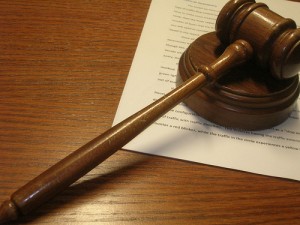
Tips and Tactics
Using Short Names
 Make the most of this practice by thinking things through at the beginning of a case. Whatever short name is selected should be one that works for the entire case and any appeal. Changing the name even once adds an opportunity for confusion that cannot benefit the client.
Some factors in selecting the short name:
Make the most of this practice by thinking things through at the beginning of a case. Whatever short name is selected should be one that works for the entire case and any appeal. Changing the name even once adds an opportunity for confusion that cannot benefit the client.
Some factors in selecting the short name:
- The name needs to be short, the shorter the better if other requirements are met. If there are word limits for briefing in the trial court or, more likely, on appeal, use
Use Spellcheckers and “Replace All” With Care
Don’t ever trust a spellchecker despite how valuable it can be. Many correctly spelled words are not the ones you intended. If possible, delete common words from the dictionary that are unlikely to be correct in context, such as pubic (public), untied (United). Some spellcheckers will automatically “fix” words the spellchecker identifies as wrong. One example is tortious (correctly spelled but not in the dictionary) which is automatically changed to “tortuous” by some versions of the Word spellchecker. Another example is “sua...
Use Space in Documents
 Attorneys focus on the words and sometimes pay no attention to the white space even though it can make significant difference in the readability of the document.
Unless you are working under a page limit and the burden of too much to say in too few pages, don’t feel obligated to cram your words into the smallest space possible.
Attorneys focus on the words and sometimes pay no attention to the white space even though it can make significant difference in the readability of the document.
Unless you are working under a page limit and the burden of too much to say in too few pages, don’t feel obligated to cram your words into the smallest space possible.
- Open space separating
Using Online Legal Dictionaries

- First (1891) and Second (1910) Editions of Black’s Law Dictionary;
- The U.S. Courts provides a glossary;
- Wex is a free legal dictionary and encyclopedia sponsored and hosted by the Legal Information Institute at the Cornell Law School. Wex entries are collaboratively created and edited by legal experts;
- Lawyers.com offers a legal dictionary based on the Merriam-Webster’s Dictionary of Law (2001);
- The World Wide Legal Information Alliance offers
How To Best Use Bullets in Briefs
 Often a listing of specific items need not or should not be numbered. Numbers may incorrectly indicate a hierarchy or ordering of the items. In these cases, bullets work well.
The material presented in bullets needs to be parallel in form and format. If one is a sentence, then all should be sentences; if one is a phrase, the rest should be similar phrases. The bullet items should normally all be in the same tense if verbs are used. Opening capitalization and ending punctuation (if any) should be the same. There is no absolute right and wrong in the style. Shorter phrases lend themselves to lower case. If any bullet will have more than a single sentence, then an initial capital and a period will be needed.
When appropriate, a short caption can introduce each bullet.
Often a listing of specific items need not or should not be numbered. Numbers may incorrectly indicate a hierarchy or ordering of the items. In these cases, bullets work well.
The material presented in bullets needs to be parallel in form and format. If one is a sentence, then all should be sentences; if one is a phrase, the rest should be similar phrases. The bullet items should normally all be in the same tense if verbs are used. Opening capitalization and ending punctuation (if any) should be the same. There is no absolute right and wrong in the style. Shorter phrases lend themselves to lower case. If any bullet will have more than a single sentence, then an initial capital and a period will be needed.
When appropriate, a short caption can introduce each bullet.
Why You Should Vary Sentence Length
 In Stanard v. Nygren, 658 F.3d 792 (7th Cir. 2011), the court criticized a complaint with at least 23 sentences with 100 or more words, including sentences of 385, 345, and 291 words. Average sentence length should be 18 to 20 words, and Word will tell you that, along with other readability indicators.
Some sentences have to be relatively long, but long sentences should be interspersed with short ones. Long sentences often can be made more comprehensible with the use of bullets or numbered lists. Sentences that are initially long when drafted can be revised into two or several shorter sentences.
Why does it matter?
In Stanard v. Nygren, 658 F.3d 792 (7th Cir. 2011), the court criticized a complaint with at least 23 sentences with 100 or more words, including sentences of 385, 345, and 291 words. Average sentence length should be 18 to 20 words, and Word will tell you that, along with other readability indicators.
Some sentences have to be relatively long, but long sentences should be interspersed with short ones. Long sentences often can be made more comprehensible with the use of bullets or numbered lists. Sentences that are initially long when drafted can be revised into two or several shorter sentences.
Why does it matter?
Want To Write Like Justice Kagan?
 Kagan often opens a sentence with a direct invocation to the reader:
She uses a "generous sprinking" of informal and even colloquial diction:
Kagan often opens a sentence with a direct invocation to the reader:
She uses a "generous sprinking" of informal and even colloquial diction:
How To Order Your Arguments
As a very general rule, arguments in a brief should appear in order of descending power or importance. A judge may stop reading on reaching a clearly winning argument or on deciding that the opening briefing is so weak as not to justify more time. Either way, there is no benefit in saving the best for last. There are a few exceptions: Jurisdictional arguments normally go first, even if they are not the strongest. If the jurisdictional argument is a winner,...
Eight Tips for Successful Proofing
Careful proofing is as important as excellent writing. Errors and omissions slip into briefs so easily, especially if several people are working on it. There are many good tips for proofing, all best employed a day or more after the writing is done: Print and proof the document in hard copy; Read the document aloud, forcing yourself to acknowledge each word, or read with your finger pointing at each word; Never try to proof for everything at once—proof the text, then the headings,...


